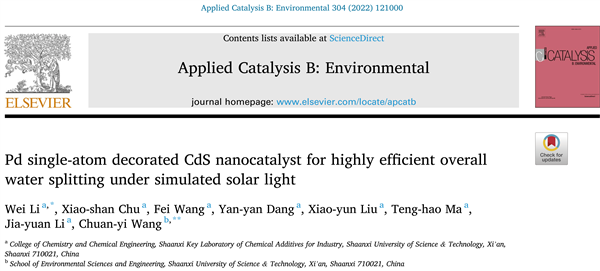Pd single-atom decorated CdS nanocatalyst for highly efficient overall water splitting under simulated solar light
writer:W. Li,* X. Chu, F. Wang, Y. Dang, X. Liu, X. Wang,* C. Wang*
keywords:Palladium single-atom, Hexagonal CdS, Overall water splitting, Hydrogen production, Simulated-solar-light
source:期刊
specific source:https://doi.org/10.1016/j.apcatb.2021.121000
Issue time:2021年

Solar-induced overall water splitting to produce hydrogen is inspiring towards energy sustainability, but it is also formidable due to its limited efficiency seriously hindering its scale up for practical application. CdS is an important transition metal sulfide with low-work-function. However, its photostability is often deteriorated due to photocorrosion influence. To overcome this issue, single-atom Pd was employed here to decorate CdS to form a CdS-Pd nanocatalyst through a simple and controllable photoinduced reduction strategy. The synergetic semiconductor (CdS)-metal (Pd) interaction promotes the fast bulk-to-surface electron migration, thereby the resultant CdS-Pd (3.83‰) nanocatalyst shows considerable structural stability and dramatically improved solar-induced HER activity in overall water splitting, about 110-fold higher than that of pristine CdS. Meanwhile, high apparent quantum yields (AQYs) of 4.47%/1.81% and 33.92%/27.49% were respectively achieved with this decorated nanocatalyst under the light of 420 nm/500 nm in absence and presence of scavenger, demonstrating the high-efficiency under broadband light illumination. Density functional theory (DFT) calculation supports that the easy formation of H* intermediates on the decorated nanocatalyst due to low energy barriers accounts for the internal promoted mechanism for hydrogen production. This study provides important insight to gain stable CdS-based photocatalysts for high-efficient hydrogen production by overall water splitting.